



1. Cyanonitrosylferrate
2. Disodium Salt Nitroprusside
3. Ketostix
4. Naniprus
5. Nipride
6. Nipruton
7. Nitriate
8. Nitropress
9. Nitroprussiat Fides
10. Nitroprusside
11. Nitroprusside, Disodium Salt
12. Nitroprusside, Disodium Salt, Dihydrate
13. Nitroprusside, Sodium
14. Sodium Nitroprusside
1. 15078-28-1
2. Pentacyanidonitrosylferrate(2-)
3. Iron(4+);nitroxyl Anion;pentacyanide
4. Pentacyano(nitroso)iron(2-)
5. Chebi:7596
6. Pentacyanidonitrosylferrate(iii)
7. [fe(cn)5(no)](2-)
8. Bdbm50377921
9. Db00325
10. Ncgc00166055-01
11. Ncgc00166055-04
12. Sbi-0206675.p002
13. C07269
14. Ab00920709_03
15. Ferrate(2-), Pentakis(cyano-.kappa.c)-nitrosyl
1. Nitroprusside Sodium
2. Nitroprusside Sodium Dihydrate
| Molecular Weight | 215.94 g/mol |
|---|---|
| Molecular Formula | C5FeN6O-2 |
| Hydrogen Bond Donor Count | 0 |
| Hydrogen Bond Acceptor Count | 12 |
| Rotatable Bond Count | 0 |
| Exact Mass | 215.948294 g/mol |
| Monoisotopic Mass | 215.948294 g/mol |
| Topological Polar Surface Area | 137 Ų |
| Heavy Atom Count | 13 |
| Formal Charge | -2 |
| Complexity | 119 |
| Isotope Atom Count | 0 |
| Defined Atom Stereocenter Count | 0 |
| Undefined Atom Stereocenter Count | 0 |
| Defined Bond Stereocenter Count | 0 |
| Undefined Bond Stereocenter Count | 0 |
| Covalently Bonded Unit Count | 7 |
For immediate reduction of blood pressure of patients in hypertensive crises, reduce bleeding during surgery, and for the treatment of acute congestive heart failure
Nitroprusside a powerful vasodilator relaxes the vascular smooth muscle and produce consequent dilatation of peripheral arteries and veins. Other smooth muscle (e.g., uterus, duodenum) is not affected. Sodium nitroprusside is more active on veins than on arteries.
Antihypertensive Agents
Drugs used in the treatment of acute or chronic vascular HYPERTENSION regardless of pharmacological mechanism. Among the antihypertensive agents are DIURETICS; (especially DIURETICS, THIAZIDE); ADRENERGIC BETA-ANTAGONISTS; ADRENERGIC ALPHA-ANTAGONISTS; ANGIOTENSIN-CONVERTING ENZYME INHIBITORS; CALCIUM CHANNEL BLOCKERS; GANGLIONIC BLOCKERS; and VASODILATOR AGENTS. (See all compounds classified as Antihypertensive Agents.)
Indicators and Reagents
Substances used for the detection, identification, analysis, etc. of chemical, biological, or pathologic processes or conditions. Indicators are substances that change in physical appearance, e.g., color, at or approaching the endpoint of a chemical titration, e.g., on the passage between acidity and alkalinity. Reagents are substances used for the detection or determination of another substance by chemical or microscopical means, especially analysis. Types of reagents are precipitants, solvents, oxidizers, reducers, fluxes, and colorimetric reagents. (From Grant and Hackh's Chemical Dictionary, 5th ed, p301, p499) (See all compounds classified as Indicators and Reagents.)
Nitric Oxide Donors
A diverse group of agents, with unique chemical structures and biochemical requirements, which generate NITRIC OXIDE. These compounds have been used in the treatment of cardiovascular diseases and the management of acute myocardial infarction, acute and chronic congestive heart failure, and surgical control of blood pressure. (Adv Pharmacol 1995;34:361-81) (See all compounds classified as Nitric Oxide Donors.)
Vasodilator Agents
Drugs used to cause dilation of the blood vessels. (See all compounds classified as Vasodilator Agents.)
Route of Elimination
One molecule of sodium nitroprusside is metabolized by combination with hemoglobin to produce one molecule of cyanmethemoglobin and four CN ions, thiosulfate reacts with cyanide to produce thiocyanate, thiocyanate is eliminated in the urine.
Metabolized by reaction with hemoglobin to produce cyanmethemoglobin and cynide ions
Approximately 2 minutes
One molecule of sodium nitroprusside is metabolized by combination with hemoglobin to produce one molecule of cyanmethemoglobin and four CN- ions; methemoglobin, obtained from hemoglobin, can sequester cyanide as cyanmethemoglobin; thiosulfate reacts with cyanide to produce thiocyanate; thiocyanate is eliminated in the urine; cyanide not otherwise removed binds to cytochromes. Cyanide ion is normally found in serum; it is derived from dietary substrates and from tobacco smoke. Cyanide binds avidly (but reversibly) to ferric ion (Fe+++), most body stores of which are found in erythrocyte methemoglobin (metHgb) and in mitochondrial cytochromes. When CN is infused or generated within the bloodstream, essentially all of it is bound to methemoglobin until intraerythrocytic methemoglobin has been saturated. Sodium nitroprusside is further broken down in the circulation to release nitric oxide (NO), which activates guanylate cyclase in the vascular smooth muscle. This leads to increased production of intracellular cGMP, which stimulates calcium ion movement from the cytoplasm to the endoplasmic reticulum, reducing the level of available calcium ions that can bind to calmodulin. This ultimately results in vascular smooth muscle relaxation and vessel dilation.